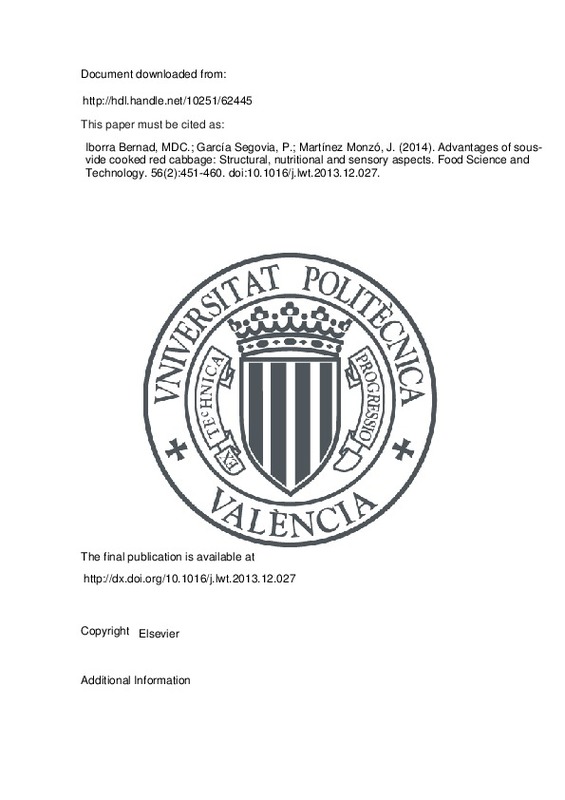JavaScript is disabled for your browser. Some features of this site may not work without it.
Buscar en RiuNet
Listar
Mi cuenta
Estadísticas
Ayuda RiuNet
Admin. UPV
Advantages of sous-vide cooked red cabbage: structural, nutritional and sensory aspects
Mostrar el registro sencillo del ítem
Ficheros en el ítem
| dc.contributor.author | Iborra Bernad, María del Consuelo
|
es_ES |
| dc.contributor.author | Tárrega, Amparo
|
es_ES |
| dc.contributor.author | García Segovia, Purificación
|
es_ES |
| dc.contributor.author | Martínez Monzó, Javier
|
|
| dc.date.accessioned | 2016-04-12T11:06:00Z | |
| dc.date.available | 2016-04-12T11:06:00Z | |
| dc.date.issued | 2014-05 | |
| dc.identifier.issn | 0023-6438 | |
| dc.identifier.uri | http://hdl.handle.net/10251/62445 | |
| dc.description.abstract | The comparison between equivalent cooking treatments should be applied in a systematic way. This study proposes a methodical way to provide cooked samples with similar firmness using two cooking treatments. In addition, the structural, nutritional and sensory properties of red cabbage cooked with sous-vide treatment in comparison with traditional cooking (boiling water) was evaluated. Changes in texture, color and anthocyanin content were measured in samples cooked with traditional cooking (for different times) and sous-vide (modifying time and temperature according to a Response Surface Methodology). Consumers described sensory properties and preferences between samples. Cryoscanning electron microscopy was used to study the samples microstructure. The firmness of samples, traditionally cooked for 11 min and preferred by consumers, was achieved in samples cooked with sous-vide treatment by optimizing of the cooking conditions (87 C/50 min or 91 C/30 min). Sous-vide treatment was preferred to traditional cooking by consumers. Sous-vide samples were more purple, more aromatic and tastier than traditionally cooked ones. The loss of anthocyanins in traditional cooking was twice that in sous-vide samples. Micrographs from different treatments showed different degrees of cell wall damage. Sous-vide treatment could be recommended as a treatment for the catering industry providing better quality products. | es_ES |
| dc.description.sponsorship | Author Iborra-Bernad was supported by the Generalitat Valenciana under FPI (Researcher Formation Program) grant. Author Tarrega was financially supported by the Juan de la Cierva programme. | en_EN |
| dc.language | Inglés | es_ES |
| dc.publisher | Elsevier | es_ES |
| dc.relation.ispartof | Food Science and Technology | es_ES |
| dc.rights | Reserva de todos los derechos | es_ES |
| dc.subject | Firmness | es_ES |
| dc.subject | Color | es_ES |
| dc.subject | Response surface methodology | es_ES |
| dc.subject | Sensory analyses | es_ES |
| dc.subject | Anthocyanins | es_ES |
| dc.subject.classification | TECNOLOGIA DE ALIMENTOS | es_ES |
| dc.title | Advantages of sous-vide cooked red cabbage: structural, nutritional and sensory aspects | es_ES |
| dc.type | Artículo | es_ES |
| dc.identifier.doi | 10.1016/j.lwt.2013.12.027 | |
| dc.relation.projectID | info:eu-repo/grantAgreement/MICINN//JCI-2009-05108/ES/JCI-2009-05108/ | es_ES |
| dc.rights.accessRights | Abierto | es_ES |
| dc.contributor.affiliation | Universitat Politècnica de València. Departamento de Tecnología de Alimentos - Departament de Tecnologia d'Aliments | es_ES |
| dc.description.bibliographicCitation | Iborra Bernad, MDC.; Tárrega, A.; García Segovia, P.; Martínez Monzó, J. (2014). Advantages of sous-vide cooked red cabbage: structural, nutritional and sensory aspects. Food Science and Technology. 56(2):451-460. doi:10.1016/j.lwt.2013.12.027 | es_ES |
| dc.description.accrualMethod | S | es_ES |
| dc.relation.publisherversion | http://dx.doi.org/10.1016/j.lwt.2013.12.027 | es_ES |
| dc.description.upvformatpinicio | 451 | es_ES |
| dc.description.upvformatpfin | 460 | es_ES |
| dc.type.version | info:eu-repo/semantics/publishedVersion | es_ES |
| dc.description.volume | 56 | es_ES |
| dc.description.issue | 2 | es_ES |
| dc.relation.senia | 255948 | es_ES |
| dc.contributor.funder | Generalitat Valenciana | es_ES |
| dc.contributor.funder | Ministerio de Ciencia e Innovación |







![[Cerrado]](/themes/UPV/images/candado.png)

